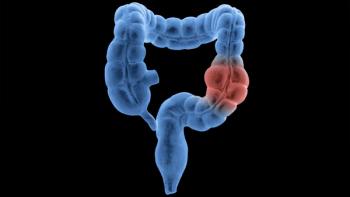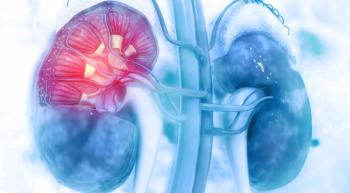
Aromatase Inhibitors Linked to Lower Incidence of Recurrence in Premenopausal ER+ Breast Cancer
Aromatase inhibitors were revealed to be more effective than tamoxifen in reducing the rate of recurrence in ER+ breast cancer among premenopausal women receiving ovarian suppression.
Premenopausal women with estrogen receptor (ER)–positive breast cancer receiving ovarian suppression experienced lower rates of recurrence following treatment with aromatase inhibitors (AI) compared with tamoxifen, according to a meta-analysis of 4 trials presented at the 2021 San Antonio Breast Cancer Symposium (SABCS).1
Specifically, the annual rate of recurrence associated with AI was 21% lower than that linked with tamoxifen (rate ratio [RR], 0.79; 95% CI, 0.69-0.90; P = .0005). The derived benefit from AI was typically observed in treatment years 0 to 4. Limited follow-up remains beyond the 10-year mark.
“Using AI rather than tamoxifen in premenopausal women receiving ovarian suppression reduces the risk of breast cancer recurrence by around 21%,” Rosie Bradley, BSc, MSc, a medical statistician at Oxford Population Health, University of Oxford, said in a presentation of the findings. “The reduction in distant recurrence [is] 17%, but [has] no effect on breast cancer mortality or overall survival; longer-term follow-up is needed to assess this effect. There's been no increase in non-breast cancer deaths and more fractures in women receiving AI.”
Researchers from the Early Breast Cancer Trialists’ Collaborative Group pooled individual data available from 7030 premenopausal women with ER-positive breast cancer who had participated in these 4 different randomized controlled trials: ABCSG 12 (NCT00295646), TEXT (NCT00066703), SOFT (NCT00066690), and HOBOE (NCT00412022). Enrolled patients had all received ovarian suppression or ablation.
Trial participants were randomized to receive either an AI or tamoxifen for a 3-year study period (in ABCSG 12) or a 5-year period in other trials (SOFT, TEXT, and HOBOE). Principle outcomes included time to invasive breast cancer recurrence, including distant, locoregional, or new contralateral breast primary, and breast cancer mortality.
Notably, the 4 trials had different chemotherapy administrations. In ABCSG 12, only neoadjuvant chemotherapy was permitted, and 5% of women received this treatment. In the TEXT trial, chemotherapy was optional, and was administered concurrently with ovarian suppression to 60% of participants. In SOFT, chemotherapy was given before randomization so long as patients remained premenopausal after completion; 54% of women in the SOFT trial received this treatment. Lastly, in HOBOE, chemotherapy was given before randomization to 63% of enrolled patients.
Overall, the absolute rate of recurrence was 14.7% vs 17.5% among those treated with AI vs tamoxifen, respectively. At a 5-year follow-up, the rate of recurrence was 10.1% vs 6.9%, respectively. Despite the distant recurrence reduction (RR, 0.83; 95% CI, 0.71-0.97; P = .02), breast cancer mortality was similar between the 2 groups (RR, 1.01; 95% CI, 0.82-1.24; P = .94). Consequently, longer follow-up is needed to properly assess the impact on morbidity, said Bradley.
Thirteen analyses investigated possible variabilities in the recurrence rate reduction across the difference subgroups. The level of significance used in these analyses was P < .01. During the periods where treatment differed and benefit was derived from the AI, factors including age, body mass index, or by tumor size, tumor grade, histological subtype, or presence and absence of chemotherapy were not found to impact reduction in recurrence proportionally.
Furthermore, despite the overall findings from the meta-analysis, women with N4+ disease did not appear to derive benefit from AI. The risk reduction for N0 was 29% (RR, 0.71; 95% CI, 0.57-0.89, P= .002), and 28% for N1-3 (RR, 0.72; 95% CI, 0.58-0.89, P= .005). An increase in risk of recurrence was associated with N4+ (RR, 1.03; 95% CI, 0.73-1.46).
“If the proportional reductions are similar in different risk categories, then the absolute benefit from AI over tamoxifen should increase with increasing risk category,” said Bradley. “Here, we are seeing a doubling of absolute gain of AI compared with tamoxifen to mock span from 2.4% in node negative to 4.8% in N1/2/3+ positive nodes. The finding we see [in] N4+ disease was unanticipated. The EBCTCG meta-analysis that compared aromatase inhibitors and tamoxifen in postmenopausal women, published in The Lancet in 2015, showed no suggestion of any lesser benefit in N4+ disease.”
Besides nodal status, clear heterogeneity in the data was between the 4 trial results (P = .004) and between HER2-negative and positive disease. The study authors noted that the latter heterogeneity may be a chance finding given the borderline statistical significance.
In addition, more women receiving AI experienced bone fractures compared with women receiving tamoxifen (5.0% vs 3.8%, respectively: P = .02), and few non-breast cancer deaths occurred (0.5% vs 0.2%, respectively; [RR, 1.29, 95% CI, 0.75-2.24]).
In a post-presentation discussion of the findings, Bradley explained that individual patient data was not available for this meta-analysis on toxicity and quality of life (QOL), but that researchers looked at individual trials that have reported on QOL and toxicity with these agents, and that there are no strong indications that QOL favor either AI or tamoxifen plus ovarian suppression.
Adverse events associated with AI include bone fractures and endometrial abnormalities. These may require specific management and therefore treatment management discussions are advised for patients and providers. Bisphosphonates may be an effective strategy to preserve bone density and reduce bone fractures, she added.
Moving forward, the QOL associated with endocrine therapy and ovarian suppression need to be considered, Bradley said.
Reference
Bradley R, Braybrooke J, Gray R, et al; Early Breast Cancer Trialists’ Collaborative Group. Aromatase inhibitors versus tamoxifen in pro menopausal women with ER+ early stage breast cancer treated with ovarian suppression: a patient level meta-analysis of 7,030 women in four randomized trials. Presented at: 2021 San Antonio Breast Cancer Symposium; December 7-10, 2021; San Antonio, TX. Abstract GS2-04.
Newsletter
Knowledge is power. Don’t miss the most recent breakthroughs in cancer care.





























































































